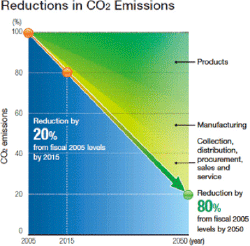
Learn more about our Green Policies & Certifications
Konica Minolta’s environmental commitment is reflected by our range of certifications and policies, including our Eco Vision 2050, Australian Packaging Covenant, Environment Management System, International ENERGY STAR rating and Ethibel Sustainability Index etc.
In everything we do, Konica Minolta strives to take care of the environment and help your corporation reduce your environmental footprint.
Our commitment is evident in our long-term and mid-term goals, as well as various certifications and programs. These include:
In January 2009, Konica Minolta formulated Eco Vision 2050 as our long-term environmental vision. This guides Konica Minolta in the right direction in terms of achieving our future objectives and fulfilling our responsibility as a global corporation by contributing to a sustainable earth and society.
2050 Eco Vision has three key targets:
Note: The target of 80% reduction of C02 emissions is based on estimates of greenhouse gas emissions by the IPCC (Panel on Climate Change) compared to population size and the amount of greenhouse gas the earth can naturally absorb. Based on these estimates, our Eco Vision 2050 sets a target of 80% reduction in emissions throughout the product lifecycle in 2050, with 2005 as the baseline.
Read more here on our global website
 | Konica Minolta has established our medium term Environmental Plan 2015 as a milestone marker toward the goals outlined in Eco Vision 2050. The plan has specific approaches and targets for four objectives:
The group has designated these objectives as goals for all of its businesses to pursue, and is incorporating them into its business plans while formulating specific measures for their achievement. |
Konica Minolta Australia is a signatory to the Australian Packaging Covenant (APC) and we have prepared an action plan to enable us to meet our obligations. We will be implementing and reporting on our action plan objectives and targets every year in accordance with the APC deadlines.
The Australian Packaging Covenant is a commitment by industry and governments to the sustainable design, use and recovery of packaging. It is Australia's way of managing the impacts of packaging and offers a highly efficient and collaborative solution.
Although many organisations have environmental reviews and audits, these alone may be insufficient in ensuring an organisation meets its legal and policy obligations.
The International Standard ISO 14001, addresses this issue by specifying requirements for an Environmental Management System (EMS) that forms a framework which companies can implement to suit their own business.
Environmental Management Systems that meet the ISO 14001 requirements can be externally audited and certified by an accredited certification body.
Konica Minolta Business Solutions Australia Pty Ltd has accreditation to AS/NZS ISO 14001:2004 Environmental Management Systems.
Konica Minolta Holdings, Inc. has appointed an executive officer in of Corporate Social Responsibility (CSR) with the authority and responsibility for group-wide environmental issues. Directors in charge of environment have also been appointed at each business company and common function company, with the authority and responsibility for environmental issues at their individual operations.
Konica Minolta Holdings, Inc. has also established an Environmental Managers' Committee headed by the General Manager of the CSR Division as an organisation for oversight of the environmental target implementation plan for the whole group. The committee meets on a quarterly basis in principle, and in addition to promoting the environmental target implementation plan, it monitors progress and manages information concerning environmental issues across the group.
Buyer’s Lab (BLI) is the leading independent authority on testing and reviewing in the imaging industry. BLI performs independent environmental testing which provides a 3rd party analysis of Konica Minolta’s devices.
BLI’s new environmental reports review the performance of document imaging products tested in their lab from an environmental standpoint. The reporting tests energy consumption in various modes, productivity in duplex modes, warm-up time and noise, as well as how well the device runs with recycled paper and reports on any energy-saving features.
In addition to BLi’s tests and reviews, Konica Minolta’s products have been awarded the following environmental certifications:
 | This program, implemented since 1995 under Japan-US agreement and made more stringent in 2007, uses the ENERGY STAR mark to label energy-saving OA equipment that meets its guidelines. ENERGY STAR is the most widely used eco-label that focuses mainly on the energy efficiency when the device is in use (on, standby, off modes). |
 | The Blue Angel Mark is the world’s first environmental label, introduced in Germany in 1978. Products and services certified as having low environmental impact are permitted to display this label. |
 | This is an international network promoting responsible management of the world’s forests. |
 | ISO14001 is a global standard for an Environmental Management System. Konica Minolta Australia has been accredited to Environmental Management Systems since February 2006. |
 | Konica Minolta Holdings has been selected for inclusion in the Ethibel Sustainability Index (ESI) - Pioneer and Excellence as of May 30, 2008. The ESI provides a comprehensive perspective on the financial performance of the world's leading companies in terms of their corporate social responsibility (CSR) and sustainability. |
 | This is certification that a product has low environmental impact, as recognised by the Japan Environmental Association. |
 | Developed and administered by the Japan Environmental Management Association for Industry, the EcoLeaf is intended to disclose quantitative data on the environmental impact of labelled products. |
 | EPEAT is a free and trusted source of environmental product ratings that makes it easy to select high-performance electronics that support organisations’ IT and sustainability goals. The system began in 2003 with a stakeholder process convened by the U.S. Environmental Protection Agency and has grown to become the definitive global environmental rating system for electronics. |
